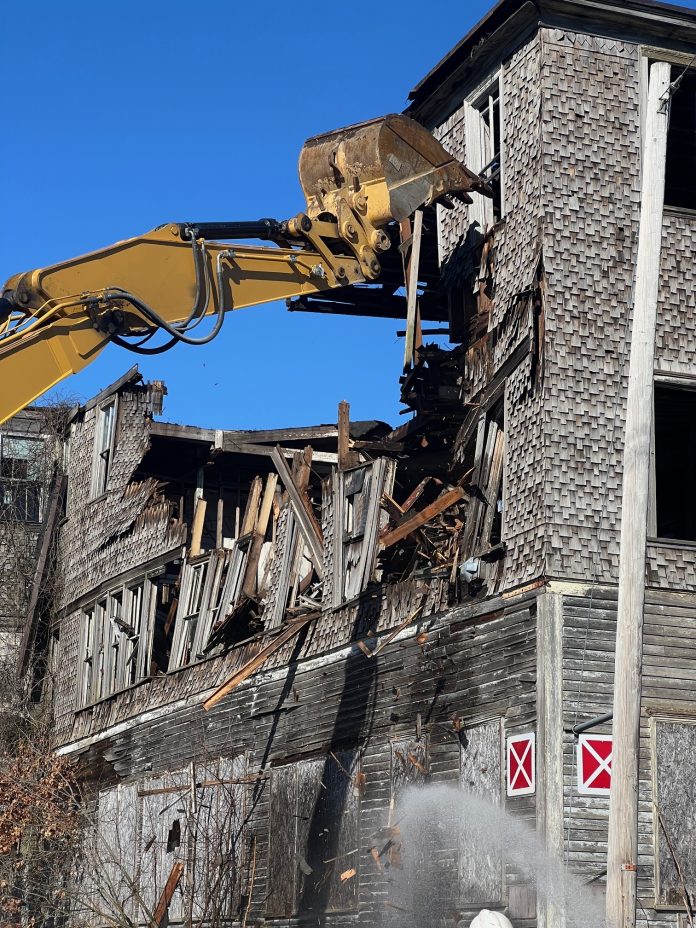
By Geena Monahan—For the North Star Reporter
Close to 40 North Attleborough residents filled Amvet Elementary School’s auditorium on July 22 to hear from members of the Environmental Protection Agency and Massachusetts Department of Environmental Protection on the ongoing cleanup of the former Webster Mill.
Assistant Town Manager Antonio Morabito began by detailing the project’s four stages: the 2024 demolition, debris removal, decontamination and development.
“What we really want to talk about tonight is what measures are we putting in place to make sure that public safety is paramount,” said Morabito.
According to Cole Hastings, the EPA‘s on-scene coordinator, work will take place between 7 a.m. and 5 p.m, Monday through Friday, with no work to occur on nights or weekends unless there is an emergency.
The majority of the debris removal will take place the first few weeks of August, but Hastings noted that the project is likely to continue into the fall in order to work at a cautious pace to mitigate risk to the community.
“We don’t do things just to hurry up and get out,” said Hastings. “Optimistically, we’re looking to get it done by the end of the year.”
Work on the site
Asbestos fibers becoming airborne is what Hastings said the EPA will work diligently to prevent. A new fire hydrant at the site to provide a continuous water supply to wet down contaminated materials and five air monitoring and sampling stations are already in place. New polythene sheeting has also been placed over the pile of debris, and North Attleborough’s Department of Public Works has cut and capped sewer lines in preparation.
Hastings also noted that the EPA is working closely with the School Department, especially as a new academic year approaches with three elementary schools in close proximity to the Broadway street location.
An off-site air monitoring station was strategically placed at Community Field to ensure safety for the children who attend camp, swim and play sports there. Four additional on-site monitoring stations will be placed to sample asbestos levels at various points on the 1.64-acre plot, and EPA workers will wear masks that can sample exposure and provide “instantaneous” results.
An estimated 7,000 cubic yards, or 8,000 tons, of debris will be removed from the site of the former silversmith factory. The majority of the mill building was demolished in March 2024, when the town executed an emergency demolition order and took down a portion of the building that was beginning to bow into the street and posed an imminent threat to residents.
Prior to demolition, a 2015 hazardous materials survey completed by Loureiro Engineering Associates, Inc. showed high-levels of chrysotile asbestos in building materials such as window glazings, roofing materials, floor tiles and thermal system insulation pipe wrap.
According to Michael Cofsky, another on-scene coordinator for the EPA, of the six different types of asbestos that exist, chrysotile is considered “good, compared to the other types” and something that the EPA deals with and removes often.
A fact sheet handed out at the forum went into further detail on the dangers of asbestos, stating that “exposure to asbestos increases your risk of developing lung disease. That risk is made worse by smoking. In general, the greater the exposure to asbestos, the greater the chance of developing harmful health effects.”
Several abutters, including a group who reside on Peterson Street directly behind the former mill, raised concerns at the end of the forum about the high water table that frequently floods their properties, and the potential for asbestos and other toxins to leak into a stream that runs behind their homes.
“If you’re going to start digging, what is the chance of asbestos getting into the water?” asked one longtime resident of Peterson Street.
Cofsky and DPW Director Mark Hollowell reminded attendees that this phase of the project works solely to remove the debris pile, and the next phase will deal with decontamination.
Hollowell added that the majority of the debris is contained in the building’s foundation, which serves as an additional barrier to the surrounding soil and groundwater, and most of the asbestos is contained within the building materials that once made up the Webster Mill.
Kate Carvalho, an environmental analyst at MassDEP, also spoke of the Wetlands Protection Act, which ensures that mitigation factors are in place to prevent any additional water contamination, such as straw bales and fencing around the perimeter.
“Once this is gone, real conversations can happen about decontamination,” said Carvalho. “The more you know, the better you can plan.”
Residents can expect to see heavy machinery and workers in protective clothing on Broadway in the coming weeks, with Hastings estimating about one truck per hour loading up material into a 30-yard dump trailer and hauling it away, with all debris wrapped in double-lined poly sheeting. A traffic plan is being finalized for the route these trucks will take to get to and from the highway.
Aaron Shaheen, community involvement coordinator for the EPA’s Office of Public Affairs, urged residents to contact him with any questions at any time during the project and not to hesitate to “see something, say something.”
Two website URLs, response.epa.gov/webstermill and epa.gov/asbestos were provided for residents looking to gain more information, along with a toll-free phone number: 1-888-EPA-7341.
